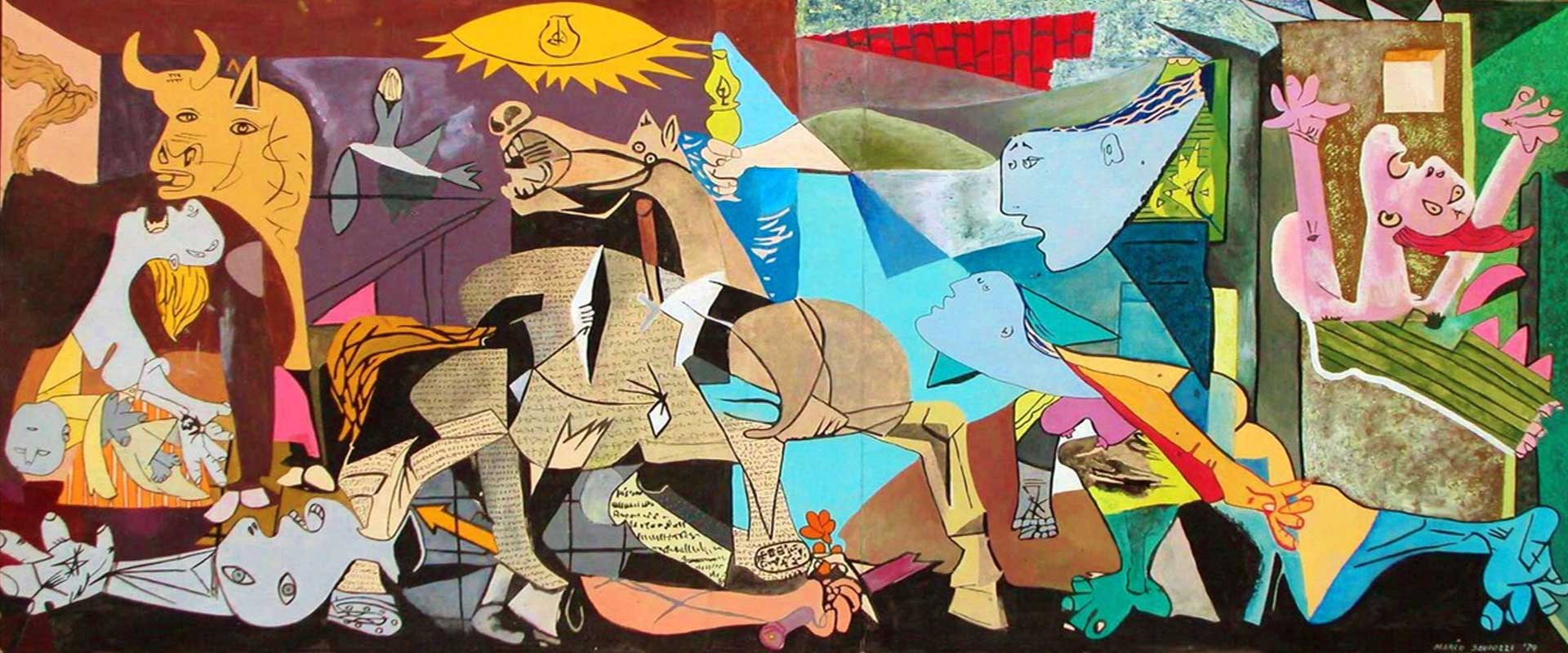The Picasso Guernica painting is one of the most powerful artistic responses to war in history. Painted in 1937 for the Spanish Pavilion at the Paris World’s Fair, it transformed tragedy into visual protest. With its fractured forms, haunting symbolism, and monumental scale, Guernica became an enduring cry against violence and oppression.
To understand the masterpiece fully, we must look at both its art analysis and its historical context—two perspectives that reveal why this canvas remains one of the defining cultural icons of the 20th century.
Historical Context of Guernica
The Spanish Civil War
On April 26, 1937, the small Basque town of Guernica was bombed by German and Italian planes supporting Francisco Franco’s fascist forces. Civilians were targeted, and the destruction shocked the world.
Picasso, living in Paris at the time, had been commissioned to create a mural for the Spanish Pavilion. The bombing gave him his subject. In a matter of weeks, he completed Guernica, forever linking art and politics in a way the world had never seen.
As discussed in Guernica Painting: The Story, Context, and Global Impact, this moment was a turning point both for Spain and for modern art.
Picasso’s Response
Though Picasso had often avoided overtly political themes, Guernica changed everything. His outrage at the atrocity found form in the language of Cubism, which fragmented reality to capture chaos and suffering.
Art Analysis of Guernica
Composition and Scale
The canvas is 25 feet wide and 11 feet tall, overwhelming viewers with its presence. The fractured arrangement of figures forces the eye to move rapidly across the scene, echoing the disorientation of violence.
- Triangular structure: Central horse, left bull, and right lamp form a dynamic composition.
- Chaotic overlap: Figures collide in distorted perspectives.
- Black-and-white palette: Stripped of color, echoing the harshness of newspaper photographs.
Symbolism in the Figures
- The Bull: Represents brutality, Spain itself, or the persistence of violence.
- The Horse: Central figure pierced and screaming, symbolizing innocent civilians.
- The Grieving Mother: Cradling her dead child, echoing pietà imagery of the Virgin Mary.
- The Fallen Soldier: Shattered on the ground, still clutching a broken sword with a small flower sprouting nearby—a fragile hope.
- The Light Bulb: Overhead, suggesting surveillance, technological destruction, or an unblinking eye of truth.
- The Woman with the Lamp: Offering a flicker of illumination amid chaos, symbolizing resilience.
As analyzed in Picasso Guernica Painting: The Symbols You Might Have Missed, subtle elements such as a skull hidden in the horse’s mouth deepen its complexity.
Visual Characteristics of Guernica
- Cubist fragmentation mirrors the shattered reality of war.
- Stark monochrome conveys bleakness and urgency.
- No clear setting, making the painting universal and timeless.
- Emotionally raw distortions evoke fear, grief, and resilience.
- Monumental size demands confrontation from viewers.
Comparison: Guernica in Relation to Other Picasso Works
| Work | Year | Theme | Visual Style | Legacy |
|---|---|---|---|---|
| The Old Guitarist | 1903 | Poverty, despair | Blue monochrome | Human empathy |
| Les Demoiselles d’Avignon | 1907 | Modernism, abstraction | Proto-Cubism | Birth of modern art |
| Guernica | 1937 | War, human tragedy | Monumental Cubist symbolism | Universal anti-war protest |
| The Weeping Woman | 1937 | Grief, personal anguish | Vivid colors, sharp distortion | Companion to Guernica |
This table shows how Guernica was both a continuation of Picasso’s style and a dramatic leap into political engagement.
Global Reception and Impact
At the Paris World’s Fair
When first exhibited in 1937, reactions were divided. Some found it incomprehensible, but others recognized its monumental force.
Touring the World
After the fair, Guernica traveled internationally to raise awareness of Spain’s plight. Exhibitions in London and New York cemented its reputation as a universal symbol of resistance.
Legacy After Franco
Picasso insisted Guernica remain outside Spain until democracy was restored. Only in 1981, after Franco’s dictatorship ended, was the painting brought to Madrid’s Museo Reina Sofía, where it remains today.
Why Guernica Still Resonates
- Universal symbolism: Speaks to all wars, not just the Spanish Civil War.
- Political icon: Reproduced in protests from Vietnam to Iraq.
- Artistic milestone: Merges modernist form with historical urgency.
- Moral force: Art as conscience, not just decoration.
As explored in Pablo Picasso Art: How He Shaped the 20th Century, Guernica represents the moment Picasso became not just an innovator, but also a global voice of protest.
Conclusion
Picasso’s Guernica is both an artistic triumph and a historical document. Its fractured forms, symbolic figures, and monumental scale capture the horror of war while offering glimmers of resilience. Rooted in the tragedy of the Spanish Civil War but transcending time and place, it remains a universal anti-war icon. To analyze Guernica is to see how art can bear witness, protest injustice, and carry a moral message that endures across generations.
FAQs on Picasso’s Guernica
What is the historical context of Guernica?
It was painted in response to the bombing of the Basque town of Guernica during the Spanish Civil War in 1937.
What does the bull symbolize in Guernica?
Interpretations vary—brutality, Franco’s fascism, or Spain’s cultural spirit.
Why is Guernica black and white?
Picasso chose monochrome to reflect newspaper reportage and emphasize stark emotional power.
Where is Guernica displayed today?
It is housed in Madrid’s Museo Reina Sofía, one of Spain’s leading modern art museums.
Why is Guernica considered important?
Because it transformed a specific tragedy into a universal statement on war, making it one of the most influential paintings of the 20th century.





